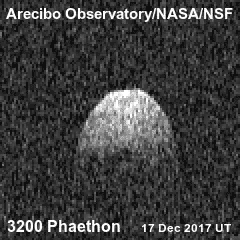
Back 3200 Phaethon Afrikaans 3200 فايثون Arabic 3200 Phaethon (كويكب) ARZ (3200) Faetont Catalan (3200) Фаэтон CE (3200) Phaethon Danish (3200) Phaethon German 3200 Φαέθων Greek 3200 Faetono Esperanto (3200) Faetón Spanish
 Radar image of 3200 Phaethon taken by Arecibo, December 17, 2017 | |
| Discovery | |
|---|---|
| Discovered by | |
| Discovery date | October 11, 1983 |
| Designations | |
| (3200) Phaethon | |
| Pronunciation | /ˈfeɪ.əθɒn/ |
Named after | Phaëthon |
| 1983 TB | |
| Adjectives | Phaethonian /feɪəˈθoʊniən/[2] |
| Orbital characteristics[1] | |
| Epoch April 27, 2019 (JD 2458000.5) | |
| Uncertainty parameter 0 | |
| Observation arc | 12,941 days (35.43 yr) |
| Aphelion | 2.4028 AU (359 million km) |
| Perihelion | 0.13998 AU (20.9 million km) |
| 1.2714 AU (190 million km) | |
| Eccentricity | 0.88990 |
| 523.6 days (1.434 yr) | |
Average orbital speed | 19.9 km/s (45,000 mph) |
| 313.94° | |
| 0° 41m 15.108s / day | |
| Inclination | 22.260° |
| 265.22° | |
| May 15, 2022[3] | |
| 322.19° | |
| Earth MOID | 0.01955 AU (2.92 million km) |
| Venus MOID | 0.0469 AU (7.02 million km)[4] |
| Jupiter MOID | 2.7375 AU (410 million km) |
| TJupiter | 4.510 |
| Physical characteristics | |
| Dimensions | 6.13±0.05 × 4.40±0.06 km[5] |
| 5.8 km (3.6 mi)[6] | |
| 3.604 hours (0.1502 d)[1] | |
| 0.1066±0.011[1] | |
| F-type asteroid[1][7] | |
| 10.7 (December 14, 2017) | |
| 14.6[1] | |
3200 Phaethon (/ˈfeɪ.əˌθɒn/; previously sometimes spelled Phaeton), provisionally designated 1983 TB, is an active[8] Apollo asteroid with an orbit that brings it closer to the Sun than any other named asteroid (though there are numerous unnamed asteroids with smaller perihelia, such as (137924) 2000 BD19).[9] For this reason, it was named after the Greek myth of Phaëthon, son of the sun god Helios. It is 5.8 km (3.6 mi) in diameter[6] and is the parent body of the Geminids meteor shower of mid-December. With an observation arc of 35+ years, it has a very well determined orbit.[1] The 2017 Earth approach distance of about 10 million km was known with an accuracy of ±700 m.[1]
- ^ a b c d e f g h Cite error: The named reference
jpldatawas invoked but never defined (see the help page). - ^ "phaeton". Oxford English Dictionary (Online ed.). Oxford University Press. (Subscription or participating institution membership required.)
- ^ JPL Horizons Observer Location: @sun (Perihelion occurs when deldot changes from negative to positive.)
- ^ Cite error: The named reference
MPCwas invoked but never defined (see the help page). - ^ "(3200) Phaethon 2021 Oct 3". Hayamizu Astro Laboratory. October 3, 2021. Retrieved February 14, 2022.
- ^ a b Cite error: The named reference
JPL20171222was invoked but never defined (see the help page). - ^ Kartashova, A.; Husarik, M.; Ivanova, O.; Kokhirova, G.; Bakanas, E.; Sokolov, I.; Khamroev, U. Kh.; Ibragimov, A. A. (June 5, 2019), "Photometric observations of the asteroid 3200 Phaethon using small and middle telescopes", Contributions of the Astronomical Observatory Skalnate Pleso, 49 (2): 367, arXiv:1906.01064, Bibcode:2019CoSka..49..367K
- ^ Cite error: The named reference
active asteroidswas invoked but never defined (see the help page). - ^ Cite error: The named reference
JPL-q141was invoked but never defined (see the help page).
© MMXXIII Rich X Search. We shall prevail. All rights reserved. Rich X Search